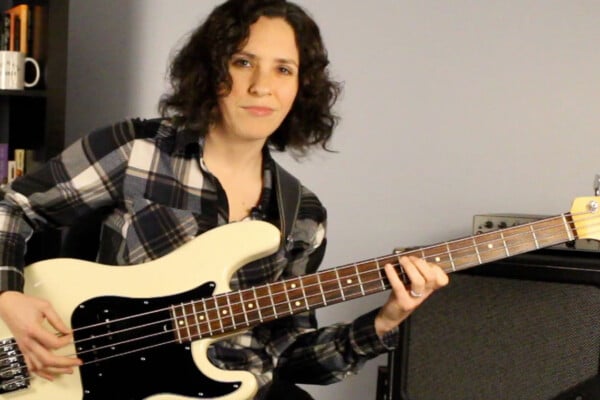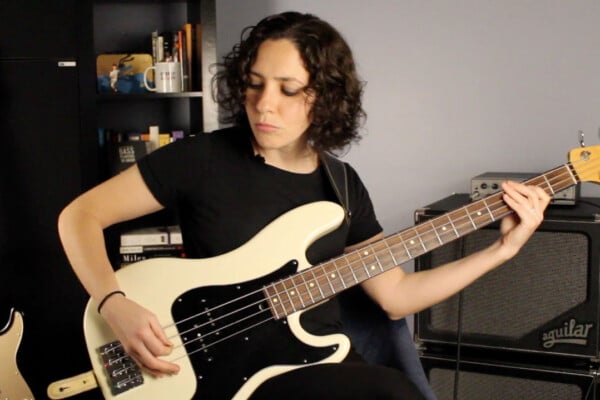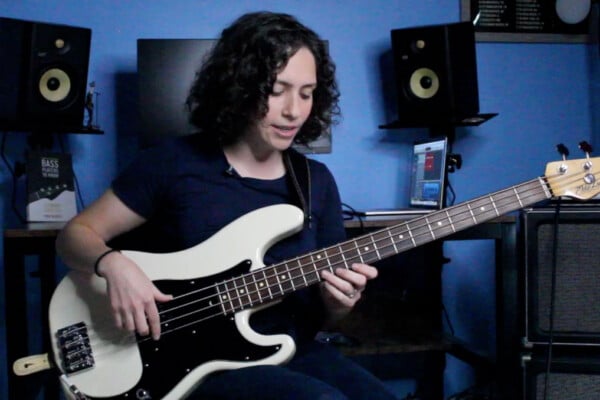Lesson: Practicing and the Mind
Today’s lesson is a preview from Jon Burr’s forthcoming “Physical and Mental Programming for the Improvising Bassist”…
In order to gain an understanding of how to practice effectively and efficiently, it is useful to have some understanding of the structure of the brain, mind and nervous system. It is possible to “practice” and not get better-or, even, to get worse, and to inculcate bad habits that will impact future ability to perform and progress. With an understanding of the nature and purpose of good habits, and how the process of learning to play occurs, we can get much more benefit from our use of time.
Structure of the brain and mind
The three layers
All animals have a brain. The human brain has three fundamental layers, and each layer has characteristics in common with other animal species. The most basic layer-the sort of brain that’s common to all animals-is present in humans in the Thalamus; it’s been referred to as the “lizard brain.” All animals have at least this part; it’s the instinctive brain; its function is to provide the drives and capabilities essential to survival. Its main functions are eating, sleeping, elimination, fighting or killing, flight, and sex. It keeps the heart beating and regulates basic bodily functions.
The “second layer” is the Limbic (or mammal) brain. It has its own separate memory system; brain cells attached to this part of the brain have been located throughout the body… researchers have found some sixty thousand brain cells in the heart! Brain cells have been located in the intestines, organs, and muscles. Receptors for neurotransmitters have been located in the blood cells and the lymphatic system, along with the network of nerves that had been thought to transmit only sensation. It has been found that there are memory cells throughout the body.
The discovery of these cells and the sort of memory structure their presence implies, which is separate from the memory in the outer layer of brain itself, has led researchers to observe that the “body is the unconscious mind.”
This leads to the question-if it’s not conscious, what is it doing with its memory? The answer is feeling. The body is the “feeling” mind — the memory cells of the limbic system remember feeling – which includes emotions, like love and fear, joy and hate, anxiety and serenity-and motion. The body remembers the feeling of motion. It also can remember body positioning in three dimensions-the so-called “psychokinetic matrix.”
Some of the following phrases may be familiar: “gut feel,” “instinct,” “learn by heart,” “in your bones,” “muscle memory.” These all refer to the activity of the Limbic brain.
This seems like a fantastic tool to have; but it’s “unconscious,” as it’s been defined. What good is it if it’s hidden from us?
It’s not hidden. It is running constantly and in parallel to our “conscious” mind, and we can become aware of its activity by focusing our awareness on it. We are accustomed to focusing on the contents of our higher brain-the Cortex, which is an amazing tool that sets humans apart. We, as Westerners, tend to equate the contents of the Cortex, with its ability to read, identify, hear, look, analyze, plan, make abstractions, understand concepts, and many other wonderful things, with not only consciousness and awareness but also with our very being. The Cortex also has its downside; it can introduce negative thinking, judgments, false conclusions, assumptions, and other toxic information into the body/mind; the Limbic body/mind will react to the contents of the Cortex, storing not the information itself, but the “feeling memory” of its reaction to the information coming from the Cortex.
We are not just our thoughts! We are the thinker of the thoughts. The Cortex is only like the movie screen of our brain, the stage on which our thoughts play out. It has its own memory, and it can be defined as the “conscious” mind; but – there is a higher level of being, the real “us,” who is capable of focusing our most powerful tool of all: awareness. This “real us” is analogous to a spotlight operator within who can shine his focused light of awareness on the different parts of the mind, and this awareness can be focused at any time on the “unconscious” activity of the limbic brain. The body/mind is hidden-right under our nose. If we have lost access to it, which most of us have to some degree, it’s because our Cortex is much more fun, a better plaything, much more interesting most of the time; and we may have been taught to ignore, suppress or disregard it. Consequently we have lost the habit of “checking in” with the Limbic side.
Unfortunately, this has negative consequences in our lives… so many of us lose touch with our feelings, which tell us how we’re doing on a daily basis; our feelings are our general state of well-being, our “spiritual condition,’ our mood. Failure to be aware of this side of our lives inevitably leads to illness, addiction, depression and other psychological conditions, undiagnosed medical illness and other problems. The Limbic brain is especially important to the musician because it’s the repository of all the motions we’re going to teach our bodies as we learn to play-and of the emotions which will eventually flow through these motions as we play.
How do we access the limbic brain? By focusing on sensation, sound, and feeling. As we practice, the Cortex must be engaged at the first steps. The fingers must be consciously instructed as to their placement. In the early going, visual aids might be appropriate, such as marks on the fingerboard. Pictures of the hands in good technical positions are very helpful. A sequence of motions must be planned an visualized. The plan is then executed-we play the passage or fragment, meanwhile still consciously monitoring the execution for quality. Once we are able to execute the planned task successfully, then we undertake to repeat it… and as we do so, shift the focus to the feeling of it. As we do this, we have begun putting the action into the Limbic memory; as we repeat it, focusing more only on the feeling of it, it gets truly “baked in,” and we have successfully accessed and programmed our body/mind!
Another method of access to the Limbic brain is through empathy and imitation. We’ve heard the expression “monkey see, monkey do.” Modeling can be an effective Limbic programming method; it takes a certain quality of attention. If the watcher can relax and try to take in the totality of the person standing before them as they execute the action, there is learning that can take place below the level of consciousness. If the student is aware of this as a learning tool, so much the better; any teacher will tell you that at times, it can be very difficult to get the student’s full attention at all. Hopefully the student will read this chapter and realize that they are equipped with a sub-conscious information sponge that is very powerful, if only they are aware enough to use it.
Another well-known technique for accessing the “unconscious” is hypnosis. Many teachers probably have wished they could do this to their students; although, sometimes in attendance of a performance of music they admire or trust, the student might enter into this state.
Steps in programming
- Use the “spotlight operator” to select mode: Look, understand, visualize, plan; choose a manageable chunk
- Execute
- Make conscious corrections and repeat
- Begin to focus on the feeling of it while repeating-access the “body/mind”
- Add metronome-learn to stay with it and maintain awareness of it while feeling it in the music
- Look away. Keep repeating, while focusing on feeling.
- Repeat by feel until it’s possible to talk while doing it




Very nice Jon. Music has emotion and shouldn't just be a series of
“monkey see, monkey do” as you mentioned above. I've seen and heard Quite a few bass players that are impressive technically but lack the soul of what matters. Thank you – Joel
Yes, valuable info, and well put! You brought some needed clarity to the limbic brain involvement. I felt that my first teachers did not engage the cortex a lot to encourage deep and fun understanding of concepts in music beyond a select few, and so lessons became tedious, boring. The limbic even included an element of negativity – fear, worry etc. It was not a pretty picture! But awareness can focus the brain and act as the driver – “we are not just our thoughts! We are the thinker of the thoughts!” That is powerful, and it can dramatically change and improve one's approach to learning music. Thank you for providing such clarity. You really have a gift to explain and enlighten!! Margaret
Yes, valuable info, and well put! You brought some needed clarity to the limbic brain involvement. I felt that my first teachers did not engage the cortex a lot to encourage deep and fun understanding of concepts in music beyond a select few, and so lessons became tedious, boring. The limbic even included an element of negativity – fear, worry etc. It was not a pretty picture! But awareness can focus the brain and act as the driver – “we are not just our thoughts! We are the thinker of the thoughts!” That is powerful, and it can dramatically change and improve one's approach to learning music. Thank you for providing such clarity. You really have a gift to explain and enlighten!! Margaret
[…] Article by Jon Burr, courtesy of our friends at http://www.notreble.com, the site for bass players. AKPC_IDS += "1734,"; Share and Enjoy: […]
Great Article john. Now I understand why noodling is such an easy diversion from a focused practice routine and why we have favorite licks. The goal is to expand that favorite lick vocabulary at our disposal.
A lot of thanks for your entire efforts on this web page. My mom really loves doing investigations and it’s simple to grasp why. A lot of people hear all of the lively manner you produce worthwhile things through your web blog and as well boost contribution from website visitors on that concept plus our simple princess is actually being taught so much. Take advantage of the remaining portion of the new year. You’re carrying out a tremendous job.